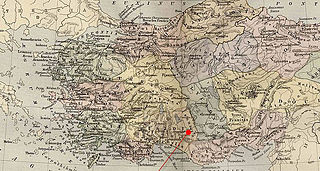Top Qs
Timeline
Chat
Perspective
Isaura Palaea
Roman and Byzantine era town in southern Turkey From Wikipedia, the free encyclopedia
Remove ads
Isaura Palaea (Ancient Greek: Ἴσαυρα Παλαιά, romanized: Isaura Palaia), in Latin Isaura Vetus, both meaning 'Old Isaura', and perhaps identical to Isauropolis,[1] was a Roman and Byzantine era town in southern Turkey.[2] The city has been identified with modern Zengibar Kalesi, Bozkır, Konya Province.[3]

In antiquity the city was in Isauria (Ἰσαυρία) district[4] of Lycaonia in today's southern Turkey (modern Konya Province). Its site is identified as near Bozkır.[1][5]
Remove ads
History

Before the Romans the town was a strongly fortified city of the Isaurians, located at the foot of Mt. Taurus. It was besieged by Perdiccas, the Macedonian regent after Alexander the Great's death, the Isaurians set the place alight and let it perish in flames rather than submit to capture.[6] Large quantities of molten gold were found afterwards by the Macedonians among the ashes and ruins.[7] The town was rebuilt, but was destroyed a second time by the Roman, Servilius Isauricus (c. 75 BCE), and thenceforth it remained a heap of ruins. Strabo states that the place was ceded by the Romans to Amyntas of Galatia.[8] It was rebuilt by Amyntas at a new location and called Isaura Nea ('New Isaura').
From 492-496 the area was fought over between emperor Anastasius I and the local rebels, in what was to become known as the Isaurian War.
The Seljuq Turks managed to take control of the area in the late 11th century, after the Battle of Manzikert.
Remove ads
References
Wikiwand - on
Seamless Wikipedia browsing. On steroids.
Remove ads
